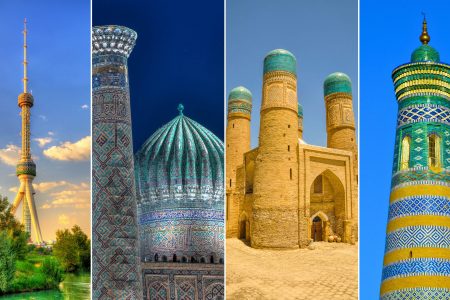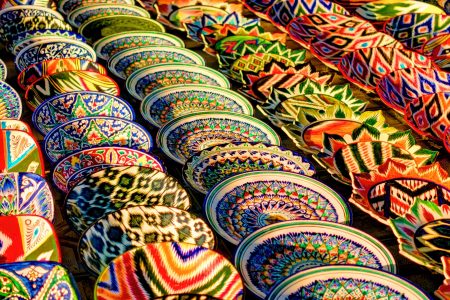Administratively, more than half of the Aral Sea is located in the southwestern part of Karakalpakstan * (an autonomous republic within Uzbekistan), while the northeastern half is in the territory of Kazakhstan. Until the 1960s, the Aral Sea area covered an average of 68,000 square km, consisting of more than 300 islands. It was the fourth largest lake in the world (after the Caspian Sea, Superior Lake in America, and Victoria Lake in Africa), and the second largest in the Eurasian continent (after the Caspian Sea). The sea stretches from northeast to southwest, and is 428 km long and 235 km wide. The basin covers an area of 69,000 km², with an average depth of about 50.5 m and a maximum depth of 69 m. While it is technically a lake, it was given the title “sea” due to its sheer size and salinity. However, during the Soviet era, large volumes of water from Amudarya and Syrdarya rivers, which supply the Aral Sea, were used for agricultural irrigation, or more specifically for cotton plantations. By 2007, the Aral Sea had lost almost 90% of its area compared to 50 years earlier and had become three separate lakes. Increased salinity has led to the extinction of flora and fauna in and around the Aral Sea. The local climate is changed because of overusing water supply for cotton watering. Summers became warmer and winters became drier and colder.
Because of a sharp decline in water volume in 1989, the Aral Sea was regarded as two separate basins – the North (Small) and South (Large) Aral Sea. In 2014, the eastern part of the South (Big) Aral Sea was completely dried up, leaving only 7,297 km². The sea, which was temporarily flooded in the spring of 2015 (10,780 km of the entire sea), shrunk to 8,303 km by the fall of that year. Bygone years, the Aral Sea was the fourth largest lake in the world, and today it is almost replaced by a vast salt desert.
One of the world’s largest environmental tragedies in the Central Asian countries and their nearly 60 million people worry about the Aral Sea problem, as it brings negative effects, with regards to the ecological, socio-economic and humanitarian situation, as well being a source of threat to the gene pool and future generations. Not only does this problem have a negative impact to the Central Asian countries, but it also has spread-effects to the entire world climate. This is truly a tragic and complicated global issue.
The basin, which regulates the climate of the Aral Sea and its role in mitigating climate across the region, has always had a positive impact on living conditions of locals, agriculture and the environment. The huge flow of air entering the region over the Aral Sea in winter warms it up and cools it down in summer.
Over the past 40 years, the area of the Aral Sea has decreased by almost 4 times, the water level by 1.8 times, and the volume of water in it by almost 9 times. Salinity of seawater increased from 9-10 g / l to 70-84 g / l. currently, the decrease in sea depth is 80-110 cm per year. Over the past 40 years, the coastline has decreased by 80–100 km. As a result, more than 4.5 million hectares of the seabed have been discovered. Today the Aral Sea is divided into three parts. The water in the shallow northern part is slightly mineralized (8-13 g / l), while the slightly larger shallow eastern part is saltier (68-72 g / l).
By the 1980s, the shrinking of the Aral Sea turned Moinak * (it was one of the main fishing ports of the Aral Sea in Uzbekistan) into a “ship cemetery,” and the region’s economic situation deteriorated from year to year.
At the present time, the tragedy of the Aral Sea alarmed people all over the world, and many scientists and researchers have visited the lake to learn more about the situation.
Former UN Secretary General Ban Ki-moon personally visited Moinak and in his number of speeches drew the attention of the world community to the difficult situation in the Aral Sea region.
Nowadays, “the Ship cemetery” in the Moinak region, is a unique place for local and foreign tourists, and is visited by thousands of tourists every year. At the moment, there is an opportunity to organise tours for tourists and make them aware with these routes in Aral Sea and its Moinak region, which attracts everyone’s attention with the unusual scenery. Although the fortune of Aral Sea is tragic, its facts and history are worth learning about.



